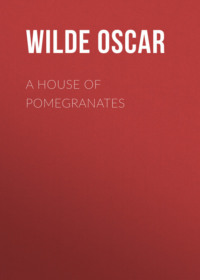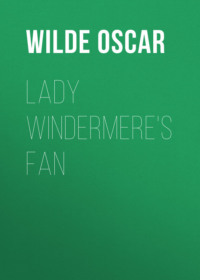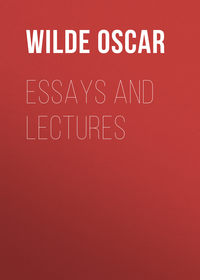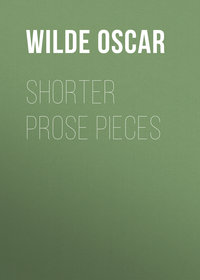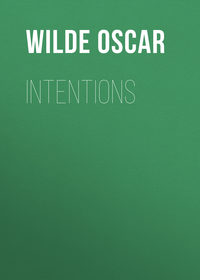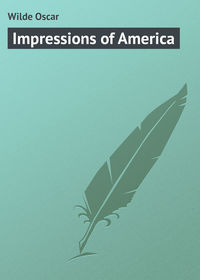 полная версия
полная версияMiscellanies
As regards Hester Grazebrook’s dresses, the first was a dress whose grace depended entirely on the grace of the person who wore it. It was merely the simple dress of a village girl in England. The second was a lovely combination of blue and creamy lace. But the masterpiece was undoubtedly the last, a symphony in silver-grey and pink, a pure melody of colour which I feel sure Whistler would call a Scherzo, and take as its visible motive the moonlight wandering in silver mist through a rose-garden; unless indeed he saw this dress, in which case he would paint it and nothing else, for it is a dress such as Velasquez only could paint, and Whistler very wisely always paints those things which are within reach of Velasquez only.
The scenery was, of course, prepared in a hurry. Still, much of it was very good indeed: the first scene especially, with its graceful trees and open forge and cottage porch, though the roses were dreadfully out of tone and, besides their crudity of colour, were curiously badly grouped. The last scene was exceedingly clever and true to nature as well, being that combination of lovely scenery and execrable architecture which is so specially characteristic of a German spa. As for the drawing-room scene, I cannot regard it as in any way a success. The heavy ebony doors are entirely out of keeping with the satin panels; the silk hangings and festoons of black and yellow are quite meaningless in their position and consequently quite ugly; the carpet is out of all colour relation with the rest of the room, and the table-cover is mauve. Still, to have decorated ever so bad a room in six days must, I suppose, be a subject of respectful wonder, though I should have fancied that Mr. Wallack had many very much better sets in his own stock.
But I am beginning to quarrel generally with most modern scene-painting. A scene is primarily a decorative background for the actors, and should always be kept subordinate, first to the players, their dress, gesture, and action; and secondly, to the fundamental principle of decorative art, which is not to imitate but to suggest nature. If the landscape is given its full realistic value, the value of the figures to which it serves as a background is impaired and often lost, and so the painted hangings of the Elizabethan age were a far more artistic, and so a far more rational form of scenery than most modern scene-painting is. From the same master-hand which designed the curtain of Madison Square Theatre I should like very much to see a good decorative landscape in scene-painting; for I have seen no open-air scene in any theatre which did not really mar the value of the actors. One must either, like Titian, make the landscape subordinate to the figures, or, like Claude, the figures subordinate to the landscape; for if we desire realistic acting we cannot have realistic scene-painting.
I need not describe, however, how the beauty of Hester Grazebrook survived the crude roses and the mauve tablecloth triumphantly. That it is a beauty that will be appreciated to the full in America I do not doubt for a moment, for it is only countries which possess great beauty that can appreciate beauty at all. It may also influence the art of America as it has influenced the art of England, for of the rare Greek type it is the most absolutely perfect example.
The Philistine may, of course, object that to be absolutely perfect is impossible. Well, that is so: but then it is only the impossible things that are worth doing nowadays!
WOMAN’S DRESS
(Pall Mall Gazette, October 14, 1884.)
Mr. Oscar Wilde, who asks us to permit him ‘that most charming of all pleasures, the pleasure of answering one’s critics,’ sends us the following remarks: —
The ‘Girl Graduate’ must of course have precedence, not merely for her sex but for her sanity: her letter is extremely sensible. She makes two points: that high heels are a necessity for any lady who wishes to keep her dress clean from the Stygian mud of our streets, and that without a tight corset ‘the ordinary number of petticoats and etceteras’ cannot be properly or conveniently held up. Now, it is quite true that as long as the lower garments are suspended from the hips a corset is an absolute necessity; the mistake lies in not suspending all apparel from the shoulders. In the latter case a corset becomes useless, the body is left free and unconfined for respiration and motion, there is more health, and consequently more beauty. Indeed all the most ungainly and uncomfortable articles of dress that fashion has ever in her folly prescribed, not the tight corset merely, but the farthingale, the vertugadin, the hoop, the crinoline, and that modern monstrosity the so-called ‘dress improver’ also, all of them have owed their origin to the same error, the error of not seeing that it is from the shoulders, and from the shoulders only, that all garments should be hung.
And as regards high heels, I quite admit that some additional height to the shoe or boot is necessary if long gowns are to be worn in the street; but what I object to is that the height should be given to the heel only, and not to the sole of the foot also. The modern high-heeled boot is, in fact, merely the clog of the time of Henry VI., with the front prop left out, and its inevitable effect is to throw the body forward, to shorten the steps, and consequently to produce that want of grace which always follows want of freedom.
Why should clogs be despised? Much art has been expended on clogs. They have been made of lovely woods, and delicately inlaid with ivory, and with mother-of-pearl. A clog might be a dream of beauty, and, if not too high or too heavy, most comfortable also. But if there be any who do not like clogs, let them try some adaptation of the trouser of the Turkish lady, which is loose round the limb and tight at the ankle.
The ‘Girl Graduate,’ with a pathos to which I am not insensible, entreats me not to apotheosise ‘that awful, befringed, beflounced, and bekilted divided skirt.’ Well, I will acknowledge that the fringes, the flounces, and the kilting do certainly defeat the whole object of the dress, which is that of ease and liberty; but I regard these things as mere wicked superfluities, tragic proofs that the divided skirt is ashamed of its own division. The principle of the dress is good, and, though it is not by any means perfection, it is a step towards it.
Here I leave the ‘Girl Graduate,’ with much regret, for Mr. Wentworth Huyshe. Mr. Huyshe makes the old criticism that Greek dress is unsuited to our climate, and, to me the somewhat new assertion, that the men’s dress of a hundred years ago was preferable to that of the second part of the seventeenth century, which I consider to have been the exquisite period of English costume.
Now, as regards the first of these two statements, I will say, to begin with, that the warmth of apparel does not depend really on the number of garments worn, but on the material of which they are made. One of the chief faults of modern dress is that it is composed of far too many articles of clothing, most of which are of the wrong substance; but over a substratum of pure wool, such as is supplied by Dr. Jaeger under the modern German system, some modification of Greek costume is perfectly applicable to our climate, our country and our century. This important fact has already been pointed out by Mr. E. W. Godwin in his excellent, though too brief, handbook on Dress, contributed to the Health Exhibition. I call it an important fact because it makes almost any form of lovely costume perfectly practicable in our cold climate. Mr. Godwin, it is true, points out that the English ladies of the thirteenth century abandoned after some time the flowing garments of the early Renaissance in favour of a tighter mode, such as Northern Europe seems to demand. This I quite admit, and its significance; but what I contend, and what I am sure Mr. Godwin would agree with me in, is that the principles, the laws of Greek dress may be perfectly realised, even in a moderately tight gown with sleeves: I mean the principle of suspending all apparel from the shoulders, and of relying for beauty of effect not on the stiff ready-made ornaments of the modern milliner – the bows where there should be no bows, and the flounces where there should be no flounces – but on the exquisite play of light and line that one gets from rich and rippling folds. I am not proposing any antiquarian revival of an ancient costume, but trying merely to point out the right laws of dress, laws which are dictated by art and not by archæology, by science and not by fashion; and just as the best work of art in our days is that which combines classic grace with absolute reality, so from a continuation of the Greek principles of beauty with the German principles of health will come, I feel certain, the costume of the future.
And now to the question of men’s dress, or rather to Mr. Huyshe’s claim of the superiority, in point of costume, of the last quarter of the eighteenth century over the second quarter of the seventeenth. The broad-brimmed hat of 1640 kept the rain of winter and the glare of summer from the face; the same cannot be said of the hat of one hundred years ago, which, with its comparatively narrow brim and high crown, was the precursor of the modern ‘chimney-pot’: a wide turned-down collar is a healthier thing than a strangling stock, and a short cloak much more comfortable than a sleeved overcoat, even though the latter may have had ‘three capes’; a cloak is easier to put on and off, lies lightly on the shoulder in summer, and wrapped round one in winter keeps one perfectly warm. A doublet, again, is simpler than a coat and waistcoat; instead of two garments one has one; by not being open also it protects the chest better.
Short loose trousers are in every way to be preferred to the tight knee-breeches which often impede the proper circulation of the blood; and finally, the soft leather boots which could be worn above or below the knee, are more supple, and give consequently more freedom, than the stiff Hessian which Mr. Huyshe so praises. I say nothing about the question of grace and picturesqueness, for I suppose that no one, not even Mr. Huyshe, would prefer a maccaroni to a cavalier, a Lawrence to a Vandyke, or the third George to the first Charles; but for ease, warmth and comfort this seventeenth-century dress is infinitely superior to anything that came after it, and I do not think it is excelled by any preceding form of costume. I sincerely trust that we may soon see in England some national revival of it.
MORE RADICAL IDEAS UPON DRESS REFORM
(Pall Mall Gazette, November 11, 1884.)
I have been much interested at reading the large amount of correspondence that has been called forth by my recent lecture on Dress. It shows me that the subject of dress reform is one that is occupying many wise and charming people, who have at heart the principles of health, freedom, and beauty in costume, and I hope that ‘H. B. T.’ and ‘Materfamilias’ will have all the real influence which their letters – excellent letters both of them – certainly deserve.
I turn first to Mr. Huyshe’s second letter, and the drawing that accompanies it; but before entering into any examination of the theory contained in each, I think I should state at once that I have absolutely no idea whether this gentleman wears his hair longer short, or his cuffs back or forward, or indeed what he is like at all. I hope he consults his own comfort and wishes in everything which has to do with his dress, and is allowed to enjoy that individualism in apparel which he so eloquently claims for himself, and so foolishly tries to deny to others; but I really could not take Mr. Wentworth Huyshe’s personal appearance as any intellectual basis for an investigation of the principles which should guide the costume of a nation. I am not denying the force, or even the popularity, of the ‘’Eave arf a brick’ school of criticism, but I acknowledge it does not interest me. The gamin in the gutter may be a necessity, but the gamin in discussion is a nuisance. So I will proceed at once to the real point at issue, the value of the late eighteenth-century costume over that worn in the second quarter of the seventeenth: the relative merits, that is, of the principles contained in each. Now, as regards the eighteenth-century costume, Mr. Wentworth Huyshe acknowledges that he has had no practical experience of it at all; in fact, he makes a pathetic appeal to his friends to corroborate him in his assertion, which I do not question for a moment, that he has never been ‘guilty of the eccentricity’ of wearing himself the dress which he proposes for general adoption by others. There is something so naïve and so amusing about this last passage in Mr. Huyshe’s letter that I am really in doubt whether I am not doing him a wrong in regarding him as having any serious, or sincere, views on the question of a possible reform in dress; still, as irrespective of any attitude of Mr. Huyshe’s in the matter, the subject is in itself an interesting one, I think it is worth continuing, particularly as I have myself worn this late eighteenth-century dress many times, both in public and in private, and so may claim to have a very positive right to speak on its comfort and suitability. The particular form of the dress I wore was very similar to that given in Mr. Godwin’s handbook, from a print of Northcote’s, and had a certain elegance and grace about it which was very charming; still, I gave it up for these reasons: – After a further consideration of the laws of dress I saw that a doublet is a far simpler and easier garment than a coat and waistcoat, and, if buttoned from the shoulder, far warmer also, and that tails have no place in costume, except on some Darwinian theory of heredity; from absolute experience in the matter I found that the excessive tightness of knee-breeches is not really comfortable if one wears them constantly; and, in fact, I satisfied myself that the dress is not one founded on any real principles. The broad-brimmed hat and loose cloak, which, as my object was not, of course, historical accuracy but modern ease, I had always worn with the costume in question, I have still retained, and find them most comfortable.
Well, although Mr. Huyshe has no real experience of the dress he proposes, he gives us a drawing of it, which he labels, somewhat prematurely, ‘An ideal dress.’ An ideal dress of course it is not; ‘passably picturesque,’ he says I may possibly think it; well, passably picturesque it may be, but not beautiful, certainly, simply because it is not founded on right principles, or, indeed, on any principles at all. Picturesqueness one may get in a variety of ways; ugly things that are strange, or unfamiliar to us, for instance, may be picturesque, such as a late sixteenth-century costume, or a Georgian house. Ruins, again, may be picturesque, but beautiful they never can be, because their lines are meaningless. Beauty, in fact, is to be got only from the perfection of principles; and in ‘the ideal dress’ of Mr. Huyshe there are no ideas or principles at all, much less the perfection of either. Let us examine it, and see its faults; they are obvious to any one who desires more than a ‘Fancy-dress ball’ basis for costume. To begin with, the hat and boots are all wrong. Whatever one wears on the extremities, such as the feet and head, should, for the sake of comfort, be made of a soft material, and for the sake of freedom should take its shape from the way one chooses to wear it, and not from any stiff, stereotyped design of hat or boot maker. In a hat made on right principles one should be able to turn the brim up or down according as the day is dark or fair, dry or wet; but the hat brim of Mr. Huyshe’s drawing is perfectly stiff, and does not give much protection to the face, or the possibility of any at all to the back of the head or the ears, in case of a cold east wind; whereas the bycocket, a hat made in accordance with the right laws, can be turned down behind and at the sides, and so give the same warmth as a hood. The crown, again, of Mr. Huyshe’s hat is far too high; a high crown diminishes the stature of a small person, and in the case of any one who is tall is a great inconvenience when one is getting in and out of hansoms and railway carriages, or passing under a street awning: in no case is it of any value whatsoever, and being useless it is of course against the principles of dress.
As regards the boots, they are not quite so ugly or so uncomfortable as the hat; still they are evidently made of stiff leather, as otherwise they would fall down to the ankle, whereas the boot should be made of soft leather always, and if worn high at all must be either laced up the front or carried well over the knee: in the latter case one combines perfect freedom for walking together with perfect protection against rain, neither of which advantages a short stiff boot will ever give one, and when one is resting in the house the long soft boot can be turned down as the boot of 1640 was. Then there is the overcoat: now, what are the right principles of an overcoat? To begin with, it should be capable of being easily put on or off, and worn over any kind of dress; consequently it should never have narrow sleeves, such as are shown in Mr. Huyshe’s drawing. If an opening or slit for the arm is required it should be made quite wide, and may be protected by a flap, as in that excellent overall the modern Inverness cape; secondly, it should not be too tight, as otherwise all freedom of walking is impeded. If the young gentleman in the drawing buttons his overcoat he may succeed in being statuesque, though that I doubt very strongly, but he will never succeed in being swift; his super-totus is made for him on no principle whatsoever; a super-totus, or overall, should be capable of being worn long or short, quite loose or moderately tight, just as the wearer wishes; he should be able to have one arm free and one arm covered, or both arms free or both arms covered, just as he chooses for his convenience in riding, walking, or driving; an overall again should never be heavy, and should always be warm: lastly, it should be capable of being easily carried if one wants to take it off; in fact, its principles are those of freedom and comfort, and a cloak realises them all, just as much as an overcoat of the pattern suggested by Mr. Huyshe violates them.
The knee-breeches are of course far too tight; any one who has worn them for any length of time – any one, in fact, whose views on the subject are not purely theoretical – will agree with me there; like everything else in the dress, they are a great mistake. The substitution of the jacket for the coat and waistcoat of the period is a step in the right direction, which I am glad to see; it is, however, far too tight over the hips for any possible comfort. Whenever a jacket or doublet comes below the waist it should be slit at each side. In the seventeenth century the skirt of the jacket was sometimes laced on by points and tags, so that it could be removed at will, sometimes it was merely left open at the sides: in each case it exemplified what are always the true principles of dress, I mean freedom and adaptability to circumstances.
Finally, as regards drawings of this kind, I would point out that there is absolutely no limit at all to the amount of ‘passably picturesque’ costumes which can be either revived or invented for us; but that unless a costume is founded on principles and exemplified laws, it never can be of any real value to us in the reform of dress. This particular drawing of Mr. Huyshe’s, for instance, proves absolutely nothing, except that our grandfathers did not understand the proper laws of dress. There is not a single rule of right costume which is not violated in it, for it gives us stiffness, tightness and discomfort instead of comfort, freedom and ease.
Now here, on the other hand, is a dress which, being founded on principles, can serve us as an excellent guide and model; it has been drawn for me, most kindly, by Mr. Godwin from the Duke of Newcastle’s delightful book on horsemanship, a book which is one of our best authorities on our best era of costume. I do not of course propose it necessarily for absolute imitation; that is not the way in which one should regard it; it is not, I mean, a revival of a dead costume, but a realisation of living laws. I give it as an example of a particular application of principles which are universally right. This rationally dressed young man can turn his hat brim down if it rains, and his loose trousers and boots down if he is tired – that is, he can adapt his costume to circumstances; then he enjoys perfect freedom, the arms and legs are not made awkward or uncomfortable by the excessive tightness of narrow sleeves and knee-breeches, and the hips are left quite untrammelled, always an important point; and as regards comfort, his jacket is not too loose for warmth, nor too close for respiration; his neck is well protected without being strangled, and even his ostrich feathers, if any Philistine should object to them, are not merely dandyism, but fan him very pleasantly, I am sure, in summer, and when the weather is bad they are no doubt left at home, and his cloak taken out. The value of the dress is simply that every separate article of it expresses a law. My young man is consequently apparelled with ideas, while Mr. Huyshe’s young man is stiffened with facts; the latter teaches one nothing; from the former one learns everything. I need hardly say that this dress is good, not because it is seventeenth century, but because it is constructed on the true principles of costume, just as a square lintel or a pointed arch is good, not because one may be Greek and the other Gothic, but because each of them is the best method of spanning a certain-sized opening, or resisting a certain weight. The fact, however, that this dress was generally worn in England two centuries and a half ago shows at least this, that the right laws of dress have been understood and realised in our country, and so in our country may be realised and understood again. As regards the absolute beauty of this dress and its meaning, I should like to say a few words more. Mr. Wentworth Huyshe solemnly announces that ‘he and those who think with him’ cannot permit this question of beauty to be imported into the question of dress; that he and those who think with him take ‘practical views on the subject,’ and so on. Well, I will not enter here into a discussion as to how far any one who does not take beauty and the value of beauty into account can claim to be practical at all. The word practical is nearly always the last refuge of the uncivilised. Of all misused words it is the most evilly treated. But what I want to point out is that beauty is essentially organic; that is, it comes, not from without, but from within, not from any added prettiness, but from the perfection of its own being; and that consequently, as the body is beautiful, so all apparel that rightly clothes it must be beautiful also in its construction and in its lines.
I have no more desire to define ugliness than I have daring to define beauty; but still I would like to remind those who mock at beauty as being an unpractical thing of this fact, that an ugly thing is merely a thing that is badly made, or a thing that does not serve its purpose; that ugliness is want of fitness; that ugliness is failure; that ugliness is uselessness, such as ornament in the wrong place, while beauty, as some one finely said, is the purgation of all superfluities. There is a divine economy about beauty; it gives us just what is needful and no more, whereas ugliness is always extravagant; ugliness is a spendthrift and wastes its material; in fine, ugliness – and I would commend this remark to Mr. Wentworth Huyshe – ugliness, as much in costume as in anything else, is always the sign that somebody has been unpractical. So the costume of the future in England, if it is founded on the true laws of freedom, comfort, and adaptability to circumstances, cannot fail to be most beautiful also, because beauty is the sign always of the rightness of principles, the mystical seal that is set upon what is perfect, and upon what is perfect only.
As for your other correspondent, the first principle of dress that all garments should be hung from the shoulders and not from the waist seems to me to be generally approved of, although an ‘Old Sailor’ declares that no sailors or athletes ever suspend their clothes from the shoulders, but always from the hips. My own recollection of the river and running ground at Oxford – those two homes of Hellenism in our little Gothic town – is that the best runners and rowers (and my own college turned out many) wore always a tight jersey, with short drawers attached to it, the whole costume being woven in one piece. As for sailors it is true, I admit, and the bad custom seems to involve that constant ‘hitching up’ of the lower garments which, however popular in transpontine dramas, cannot, I think, but be considered an extremely awkward habit; and as all awkwardness comes from discomfort of some kind, I trust that this point in our sailor’s dress will be looked to in the coming reform of our navy, for, in spite of all protests, I hope we are about to reform everything, from torpedoes to top-hats, and from crinolettes to cruises.


